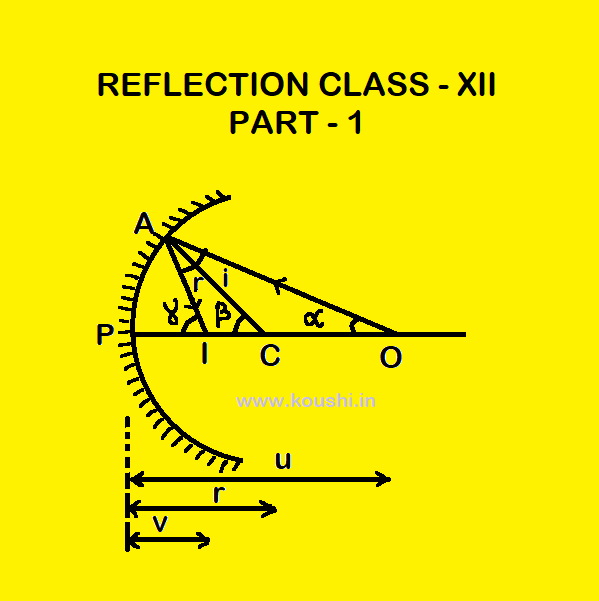Reflection through spherical surface:
The basic definition of centre of curvature, radius of curvature, pole, aperture, principle axis, principle focus, focal plane, focal length etc. are explained in the blog of ‘Reflection through curved surface class – X‘.
To get the informations click the given button.
Sign convention for reflection by spherical mirror:
1. All the distances are measured from the pole of the spherical mirror.
2. Distances are measured in the direction of incident ray are taken as positive, and the distances are measured in the opposite direction of incident ray are taken as negative.
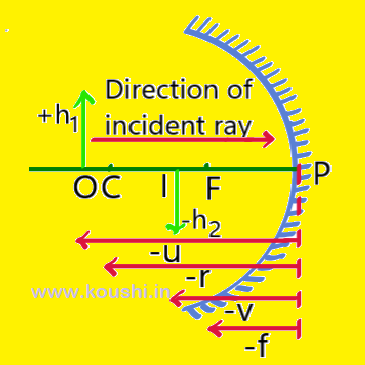
3. The upward distances (erect) perpendicular to the principle axis are taken as positive and the downward distances (inverted) perpendicular to the principle axis are taken as negative.
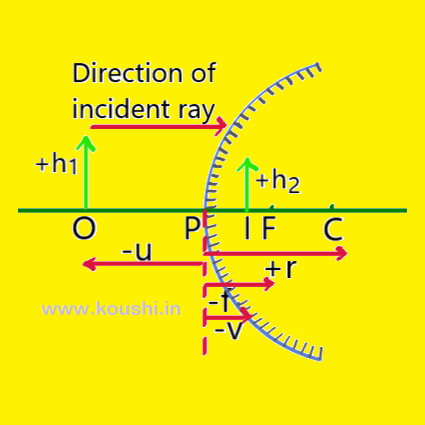
Relation between focal length and radius of curvature:
Let us consider AB is the incident ray parallel to the principle axis of a concave mirror of radius of curvature R (= PC) and focal length f (= PF). After reflection from point B the ray pass through the focus F. CB is the normal at point B. ![]()
![]()
![]() is the angle of incidence and
is the angle of incidence and ![]()
![]()
![]() is the angle of reflection.
is the angle of reflection.
![]()
![]()
![]() [i.e. i = r] ——-(1)
[i.e. i = r] ——-(1)
![]()
![]()
![]() [alternate angle] ——(2)
[alternate angle] ——(2)
So, from equation (1) and equation (2) ![]()
![]()
![]() so, FC = FB ——-(3).
so, FC = FB ——-(3).
Since point B is very closed to P and the aperture of the mirror is very small, so instead of B we can write P. i.e. FB = PF ——(4).
From equation (3) and equation (4) FC = PF,
Or, PF = PC – FC
Or, PF = PC – PF
Or, 2PF = PC
Or, 2(-f) = (-R)
![]() f
f ![]()
![]() .
.
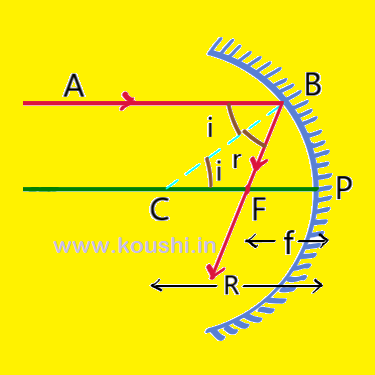
Image formation by a concave and convex mirror: Concave mirror produces real image when object is placed in between infinity and focus. The size of image depends on the position of object. When object is placed in between focus and pole of the concave mirror, image is virtual magnified and behind the mirror. whereas concave mirror produces virtual diminished image for any position of object. These are explained in the blog of ‘Reflection through curved surface class – X‘.
To get the informations click the given button.
Use of mirror: Concave mirror are used as shaving mirror or in make up purpose. It is used by dentist. Convex mirror is used as a rear-view mirror. These are explained in the blog of ‘Reflection through curved surface class – X‘.
To get the informations click the given button.
Mirror formula: Let us consider OP is the principle axis of a concave mirror where P is the pole and C is the centre of curvature of the mirror. Ray comes from point O incident at point A on the mirror and reflects from A forms image at point I. ∠i and ∠r are the angle of incidence and angle of reflection respectively.
Object distance = PO = – u, image distance = PI = – v. Radius of curvature = PC = – r and focal length f = ![]() .
.
Let us consider, ![]() ,
, ![]() and
and ![]() are the angles of OA, CA and IA with OP respectively. As the aperture of the mirror is very small, then all the angles are also very small and PA is perpendicular to OP.
are the angles of OA, CA and IA with OP respectively. As the aperture of the mirror is very small, then all the angles are also very small and PA is perpendicular to OP.
Then, tan![]() =
= ![]() =
= ![]() , tan
, tan![]() =
= ![]() =
= ![]() and tan
and tan![]() =
= ![]() =
= ![]()
From, ![]() OAC, ∠PCA = ∠OAC + ∠AOC
OAC, ∠PCA = ∠OAC + ∠AOC
Or, ![]() = i +
= i + ![]()
Or, i = ![]() –
– ![]() ——-(i)
——-(i)
From, ![]() IAC, ∠PIA = ∠ACI + ∠CAI
IAC, ∠PIA = ∠ACI + ∠CAI
Or, ![]() =
= ![]() + r
+ r
Or, r = ![]() –
– ![]() ——-(ii)
——-(ii)
From equation (i) and equation (ii), ![]() i =
i = ![]() r
r
Or, ![]() –
– ![]() =
= ![]() –
– ![]()
Or, 2![]() =
= ![]() +
+ ![]()
Or, 2![]() =
= ![]() +
+ ![]()
Or, – ![]() = –
= – ![]() –
– ![]()
Or, ![]() =
= ![]() +
+ ![]()
![]()
![]() [as f =
[as f = ![]() ] this is mirror formula.
] this is mirror formula.
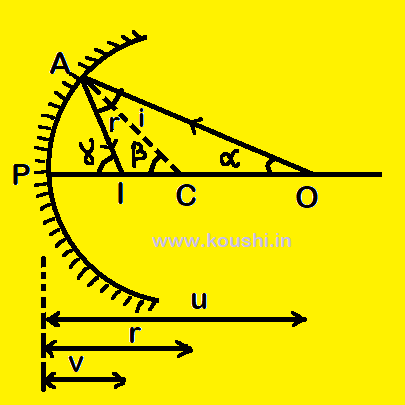
Magnification power: The magnification is the ratio of the size (or height) of the image to the size (or height) of the object. m = – ![]() =
= ![]() . Where h1 is the height of object and h2 is the height of image. For real image h2 is —ve, and m is —ve, for virtual image h2 is +ve and m is +ve.
. Where h1 is the height of object and h2 is the height of image. For real image h2 is —ve, and m is —ve, for virtual image h2 is +ve and m is +ve.
Detailed information of magnification is given in the blog of ‘Reflection through curved surface class – X‘. To get the information click the given button.
Click the button to go to the next part of this chapter.
